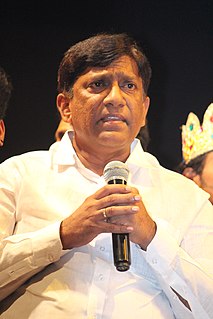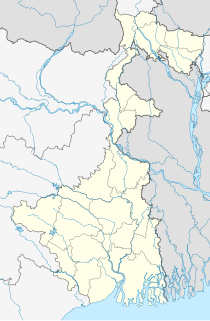Transport in India consists of transport by land, water and air. Public transport is the primary mode of road transport for most Indian citizens, and India's public transport systems are among the most heavily used in the world.

The Chennai Mass Rapid Transit System, a state-owned subsidiary of Indian Railways, is a metropolitan elevated railway line in Chennai, India. Operated by the Southern Railways, it is the first elevated railway line in India and also the country's longest elevated corridor spanning 17 km. Although it is segregated from the Chennai Suburban Railway, they both are operated by Southern Railway and are integrated in a wider urban rail network. Built at a cost of ₹ 15,710 million, the line runs within the city limits from Chennai Beach to Velachery, covering a distance of 19.34 km (12.02 mi) with 18 stations, with an average daily ridership of 100,000 commuters. Connecting the central business area of old Madras with the IT corridor, the section has a potential capacity of 425,000 passengers a day. In 2011–2012, MRTS registered a revenue of ₹ 198.9 million, registering a 16.25 percent increase, with 134 trains plying across all the 17 stations.

The Greater Chennai Corporation, formerly known as the Corporation of Madras (1668-1996) and Corporation of Chennai (1996-2016), is the civic body that governs the city of Chennai, Tamil Nadu, India. Inaugurated on 29 September 1688, under a Royal Charter issued by King James II on 30 December 1687 as the Corporation of Madras, it is the oldest municipal body of the Commonwealth of Nations outside Great Britain. It is among the oldest municipalities in Asia after Daman Municipality, which was established in 1588. It is the largest municipal corporation is Tamil Nadu with an area of 426 km2. It is headed by a mayor, who presides over 200 councillors each of whom represents one of the 200 wards of the city. It is the second oldest city civic body in the world after the City of London.

Chennai Port, formerly known as Madras Port, is the second largest container port of India, behind Mumbai's Nhava Sheva. The port is the largest one in the Bay of Bengal. It is the third-oldest port among the 13 major ports of India with official port operations beginning in 1881, although maritime trade started much earlier in 1639 on the undeveloped shore. It is an artificial and all-weather port with wet docks. Once a major travel port, it became a major container port in the post-Independence era. An established port of trade of British India since the 1600s, the port remains a primary reason for the economic growth of Tamil Nadu, especially for the manufacturing boom in South India, and has contributed greatly to the development of the city of Chennai. It is due to the existence of the port that the city of Chennai eventually became known as the Gateway of South India. The port has become a hub port for containers, cars and project cargo in the east coast of India. From handling a meagre volume of cargo in the early years of its existence, consisting chiefly of imports of oil and motors and the export of groundnuts, granite and ores, the port has started handling more than 60 million tonnes of cargo in recent years. In 2008, the port's container traffic crossed 1 million twenty-foot equivalent units (TEUs). As of 2011, the Chennai Port was ranked the 86th largest container port in the world and there were plans to expand the capacity to about 140 million tonnes per annum. It is an ISO 14001:2004 and ISPS-certified port and has become a main line port having direct connectivity to more than 50 ports around the world.
Kamarajar Port Limited, formerly Ennore Port, is located on the Coromandel Coast about 18 km north of Chennai Port, Chennai, it is the 12th major port of India, and the first port in India which is a public company. The Kamarajar Port Limited is the only corporatised major port and is registered as a company. Chennai Port Trust acquired around 67% stake of Centre in the Kamarajar Port Limited on 27 March 2020. The remaining 23 percent was held by the Chennai Port Trust. The port has been able to attract an investment of ₹ 26,000 million by private entrepreneurs on various terminals and harbour craft. Kamarajar Port Limited, designed as Asia's energy port, is the first corporatised port in India and has only 86 employees. Envisaged being a satellite port to decongest and improve the environmental quality at the bustling Chennai Port, Kamarajar Port Limited is evolving itself into a full-fledged port with the capacity to handle a wide range of products. With a permissible draught of 13.5 m, the port handled a total volume of 11.01 million tonnes in 2010–11, up by 2.86 per cent from the previous year.

Mangalore International Airport, is an international airport serving the coastal city of Mangalore, India. It is one of the two international airports in Karnataka, the other being Kempegowda International Airport, Bangalore. Mangalore International Airport is the second busiest airport in Karnataka. In addition to domestic destinations, flights depart daily for major cities in the Middle East. The airport was named Bajpe Aerodrome, when it opened on 25 December 1951, former Prime Minister Jawaharlal Nehru arrived then on a Douglas DC-3 aircraft.

Boianapalli Vinod Kumar is an Indian politician, advocate and Ex Member of Parliament. He represents the Karimnagar constituency of Telangana State and previously represented Hanamkonda in the 14th Lok Sabha (2004-2009). He is one of the founding members of the Telangana Rashtra Samithi (TRS) party and is presently a politburo member and the party's deputy Floor Leader in the Lok Sabha. present he is vice chairman of planning commission for telangana.

Inland Waterways Authority of India (IWAI) is the statutory authority in charge of the waterways in India. It was constituted under IWAI Act-1985 by parliament of India Its headquarters is located in Noida, UP. India has an extensive network of inland waterways in the form of rivers, canals, backwaters and creeks. The total navigable length is 14,500 km, out of which about 5200 km of the river and 4000 km of canals can be used by mechanised crafts. Freight transportation by waterways is highly under-utilised in India compared to other large countries and geographic areas like the United States, China and the European Union. The total cargo moved by the inland waterway was just 0.1% of the total inland traffic in India, compared to the 21% figure for United States. Cargo transportation in an organised manner is confined to a few waterways in Goa, West Bengal, Assam, and Kerala.

The West Coast Canal or National Waterway No 3 is a 205-km stretch of this inland navigational route located in Kerala, India and runs from Kollam to Kottapuram and was declared a National Waterway in 1993. In addition to the main stretch, Champakara and Udyogmandal canals are navigable and connect the industrial centers of Kochi to Kochi port Inland Waterways Authority of India (IWAI) under the Ministry of Shipping is coordinating the task for developing, monitoring and administering national waterways. It is the first National Waterway in the country with 24-hour navigation facilities along the entire stretch. It has been extended to Kozhikode as per National Waterways Act, 2016. The National Waterway 3 is passing mainly through the alignment of erstwhile Thiruvananthapuram–Shoranur canal.

The Bureau of Indian Standards (BIS) is the National Standards Body of India under Department of Consumer affairs, Ministry of Consumer Affairs, Food & Public Distribution, Government of India. It is established by the Bureau of Indian Standards Act, 2016 which came into effect on 12 October 2017. The Minister in charge of the Ministry or Department having administrative control of the BIS is the ex-officio President of the BIS. BIS has 500 plus scientific officers working as Certification Officers, Member secretaries of technical committees and lab OIC's.

National Waterway 4 (NW-4) is a 1,095 kilometres (680 mi) long waterway in India. It has been declared as an Indian National Waterway and is currently under development. It connects the Indian states of Telangana, Andhra Pradesh, Tamil Nadu, and the union territory of Puducherry. The NW-4 runs along the Coromandal Coast through Kakinada, Eluru, Commanur, Buckingham Canals and also through part of Krishna and Godavari rivers in South India. It was declared a National Waterway on 24 November 2008 under the Provisions of National Waterways Bill, 2006. It is being developed by the Inland Waterways Authority of India (IWAI), and was scheduled for completion by 2013. The National Waterways Act, 2016 has extended the length of NW-4 from 1,078 km (670 mi) to 2,890 km (1,800 mi) by connecting the Krishna and Godavari Rivers. The Project would be undertaken in 3 phases with first phase beginning in October, 2017 and to be completed by June, 2019
Officially known as The Constitution Act, 2016, this amendment introduced a national Goods and Services Tax (GST) in India from 1 July 2017. It was introduced as the One Hundred and Twenty Second Amendment Bill of the Constitution of India,

New Gitaldaha railway station is on the broad-gauge Alipurduar–Bamanhat branch line.

The Mines and Minerals Act (1957) is an Act of the Parliament of India enacted to regulate the mining sector in India. It was amended in 2015 and 2016. This act forms the basic framework of mining regulation in India.

The Kaladan Road Project is a US$484 million project connecting the eastern Indian seaport of Kolkata with Sittwe seaport in Rakhine State, Myanmar by sea. In Myanmar, it will then link Sittwe seaport to Paletwa in Chin State via the Kaladan river boat route, and then from Paletwa by road to Mizoram state in Northeast India. All components of the project, including Sittwe port and power, river dredging, Paletwa jetty, have been completed, except the under construction Zorinpui-Paletwa road. Originally, the project was scheduled to be completed by 2014, but end-to-end project is expected to be fully operational only by March 2023 as per March 2021 update.

Visakhapatnam Port is one of 13 major ports in India and the only major port of Andhra Pradesh. It is India's third largest state-owned port by volume of cargo handled and largest on the Eastern Coast. It is located midway between the Chennai and Kolkata Ports on the Bay of Bengal.

Radhikapur is a village and a gram panchayat in Kaliaganj CD block in Raiganj subdivision of Uttar Dinajpur district in the state of West Bengal, India. It is a border checkpoint on the Bangladesh-India border.

The National Waterways Act, 2016 is an Act of Parliament of India. It was tabled in Lok Sabha by Minister of Shipping, Road Transport and Highways Nitin Gadkari on 5 May 2015. The Act merges 5 existing Acts which have declared the 5 National Waterways and proposes 101 additional National Waterways. The Act came into force from 12 April 2016.
The Citizenship (Amendment) Act, 2019 was passed by the Parliament of India on 11 December 2019. It amended the Citizenship Act, 1955 by providing a pathway to Indian citizenship for persecuted religious minorities from Afghanistan, Bangladesh and Pakistan who are Hindus, Sikhs, Buddhists, Jains, Parsis or Christians, and arrived in India before the end of December 2014. The law does not grant such eligibility to Muslims from these Muslim-majority countries. The act was the first time that religion had been overtly used as a criterion for citizenship under Indian law and attracted global criticism.
The Farmers' Produce Trade and Commerce Act, 2020 was an act of the Indian Government that permits intra-state and inter-state trade of farmers’ produce beyond the physical premises of Agricultural Produce Market Committee (APMC) market yards (mandis) and other markets notified under state APMC Acts.













